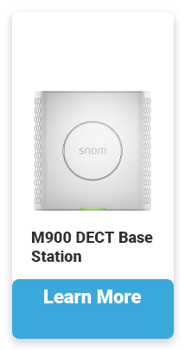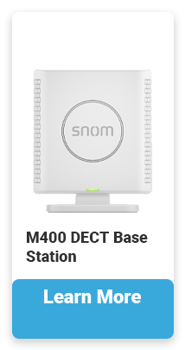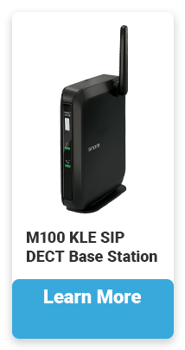 The quest for robust, efficient, cost-effective phone systems is relentless in today's rapidly evolving telecommunication landscape. Two technologies frequently found at the center of this discourse are WiFi Voice over Internet Protocol (VoIP) and Digital Enhanced Cordless Telecommunications (DECT). While both systems are emblematic of significant strides in telecommunication, they present unique advantages and challenges. This white paper aims to dissect these technologies, laying bare the inherent challenges of WiFi VoIP, particularly in configuration and frequency interference, and juxtaposing these against the merits of DECT.
The quest for robust, efficient, cost-effective phone systems is relentless in today's rapidly evolving telecommunication landscape. Two technologies frequently found at the center of this discourse are WiFi Voice over Internet Protocol (VoIP) and Digital Enhanced Cordless Telecommunications (DECT). While both systems are emblematic of significant strides in telecommunication, they present unique advantages and challenges. This white paper aims to dissect these technologies, laying bare the inherent challenges of WiFi VoIP, particularly in configuration and frequency interference, and juxtaposing these against the merits of DECT.
Configuration Complexity

WiFi VoIP necessitates an elaborate network setup. The exigencies of configuring a WiFi VoIP system extend beyond mere technical know-how, often requiring network enhancements to cater to voice traffic. The setup process may be prolonged and pose hurdles for establishments needing more in-house technical expertise.

On the other hand, DECT is synonymous with ease of configuration. Its plug-and-play nature starkly contrasts the rigors associated with WiFi VoIP setup. DECT systems require minimal configuration, reducing setup times significantly. This simplicity does not compromise the system’s functionality, making DECT a desirable choice for business settings.
Frequency Interference

The susceptibility of WiFi VoIP to frequency interference is a notable drawback. Sharing frequency bands with other wireless devices often culminates in interference, resulting in call drops and degraded call quality. The situation exacerbates in densely populated wireless networks, leading to inconsistent communication experiences.

Conversely, DECT operates on a dedicated frequency band, its forte. This dedicated bandwidth significantly minimizes interference, ensuring a consistent, high-quality call experience. The insulation from other wireless devices operating in proximity is a hallmark of DECT’s reliable performance.
Network Load & Capacity

WiFi VoIP systems incrementally load existing WiFi networks. As the number of WiFi VoIP users burgeons, the strain on the network escalates, often leading to scalability bottlenecks. This is particularly discernible in larger establishments where network traffic is continuous.

DECT, with its independent network, ameliorates such concerns. It fosters scalability by alleviating the load on existing networks. The DECT base stations can handle many simultaneous calls, providing a scalable solution that grows in tandem with organizational needs.
Security & Reliability

WiFi VoIP operates within shared network environments, which, despite encryption protocols, can present security challenges. The shared frequency band and network resources could expose voice traffic to unauthorized interception or eavesdropping. Furthermore, the reliability of WiFi VoIP can be compromised in congested network environments, leading to inconsistent call quality and service availability.

In contrast, DECT boasts enhanced security protocols, including robust encryption standards that safeguard voice traffic from unauthorized access. The dedicated frequency band and network resources of DECT ensure a high degree of reliability, with consistent call quality and service availability, even in challenging or congested network environments..
Cost Implication

The Total Cost of Ownership (TCO) is a pivotal consideration for decision-makers. WiFi VoIP may necessitate network enhancements to cater to the increased load, potentially elevating the TCO. Furthermore, the costs associated with troubleshooting and mitigating frequency interference and security issues can add up over time.

On the other hand, DECT often presents a lower TCO due to its simplified configuration and minimal maintenance requirements. The initial investment in DECT infrastructure can be offset by reduced maintenance costs, fewer network enhancements, and lower troubleshooting costs, making it a cost-effective solution in the long run.
Performance Metrics

A comparative analysis of key performance indicators such as call quality, latency, and range reveals pronounced differences. WiFi VoIP may experience fluctuating call quality and higher latency, especially in congested or interference-prone environments. The operational range can also be limited depending on the WiFi network coverage.

With its dedicated frequency band and network resources, DECT offers superior call quality, lower latency, and a more extended operational range. DECT’s performance consistency makes it a more reliable choice for critical communication needs within organizations.
The comparative analysis elucidates DECT’s superior attributes in overcoming WiFi VoIP’s inherent challenges. DECT is a robust, reliable, cost-effective telephony solution that mitigates configuration complexity, frequency interference, network load, and security concerns. Its merits extend to a plethora of organizational settings, underscoring its potency as a telecommunications asset.
Snom offers scalable DECT solutions that range from single-cell DECT to large-scale DECT networks that support up to 4,000 handsets that can roam over square miles of area.
Our DECT Solutions





